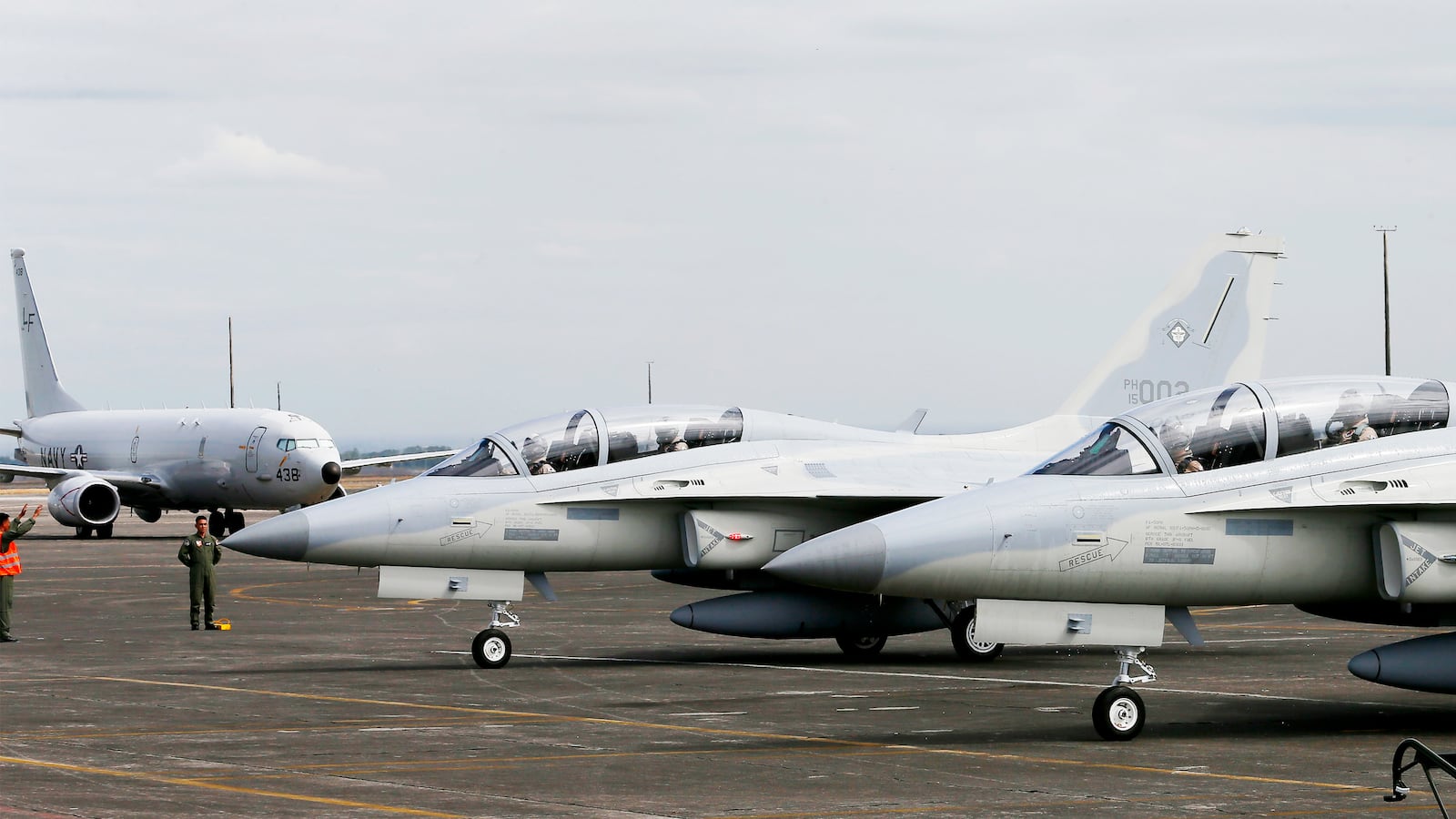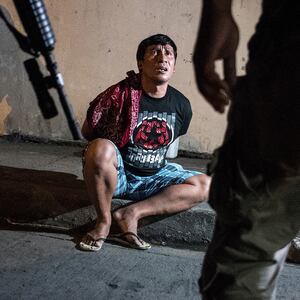CLARK FREEPORT, Philippines—The tarnished carcasses of old fighter planes litter the landscape here, relics of what once was the biggest American air base outside the United States. In the Cold War days, combat aircraft and transports would take off in their hundreds, heading for targets from the Middle East to Vietnam to Korea. But these days, as new Cold Wars loom on the horizon with Russia and especially China, this historic former base is a symbol of emptiness in American defense policy.
The storied parade ground is still here, an expanse of greensward over which generals once presided as the base grew from an old Spanish cavalry post in 1898 to a symbol of global U.S. power.
As tremors in mid-June 1991 shook Mount Pinatubo, looming ominously 10 miles to the west, a U.S. Geological Survey team warned of one of history’s most dramatic volcanic blasts. The American commander, Air Force Major General William Studer, ordered the withdrawal of all 14,500 troops and civilians along with almost all the planes two days before the first of 42 eruptions in three days coughed up a firestorm of lava, mud and dust.
The Americans would never return—but not because the base, covered by ash and volcanic mud was beyond repair. The reason was rejection three months later of a new bases treaty by a Philippine senate eager to defy the “imperial power” that had ruled the Philippines as successor to the Spanish until the Japanese in 1942 inflicted one of the most humiliating defeats in U.S. military history.
True, the Americans, having recovered the country in terrible battles with the Japanese in 1945, granted independence to the Philippines in 1946, appropriately on July 4. But over the years Philippine “nationalists,” as they called themselves, resented the close ties between the Americans and Philippine leaders, notably the long-ruling Ferdinand Marcos, deposed in 1986 in a bloodless “People Power” revolution. In 1991 the senate president, Jovito Salonga, proudly cast the deciding ballot as the senate spurned the treaty, 12 to 11, a triumph recounted by Salonga in his book, The Senate that Said No.
The Americans were gone for good—and not only from Clark but from Subic Bay, their biggest overseas naval base, on the other side of Pinatubo, 47 miles southwest in the South China Sea.
Today, the Chinese Communist Party is claiming more of those waters as its own. And this place that is now a tawdry Philippine Air Force base is a sad symbol of misplaced nationalism at a time when officials in Manila watch with consternation as Beijing marauds.
China purports to rule virtually all the South China Sea, menacing Philippine forces still clinging to tiny enclaves in the Spratly Islands where the Chinese have built an air strip and facilities for warships. As if that weren’t enough, Chinese boats, buoys and a floating chain keep Philippine fishermen from the fish-rich Scarborough Shoal, long claimed by the Philippines, 165 miles west of Subic.
President Rodrigo Duterte, best known for his brutal crackdown on drug dealers and users, has been trying to curry favor with China’s President Xi Jinping, whom he saw last week on his fifth trip to Beijing since his election three years ago.
Talk of a revival of the old relationship between the U.S. and the Philippines, still bound by a mutual defense treaty with the United States dating from 1951, has faded since Duterte stopped American warships from paying courtesy calls at Subic. Several thousand U.S. and Philippine troops do stage annual Balikatan—“shoulder to shoulder”—exercises but stay clear of the Chinese, a force the Americans are in no position to challenge without their historic bases.
Reminders of a bygone era are visible around the Clark Freeport in the form of old buildings that once served the Americans. Some are hollow shells, others rebuilt after a wave of looting in which Filipinos, with the connivance of high-ranking military officers, stripped the base of just about anything that might be sold on the open market, including copper wiring, pipes, and plumbing, as well as weapons and expensive electronic gadgetry. That era of massive thievery, an epidemic that officials prefer not to discuss, appears forgotten while planners welcome new investment, and headlines proclaim the dangers posed by the Chinese.
The contrast between old and new times is nowhere so clear as in the transition of Clark Field from a strategic military base to a civilian airport. The Philippine Air Force, reduced to a handful of helicopters, old transports and jet trainers, manages only occasional flights off a single strip serving a dozen airliners packed with hard-charging passengers in pursuit of all the fun on offer at both Clark and in adjacent Angeles City.
“We say there’s not just life after the bases,” says Noel Tulabut, communications manager of the Clark Development Corporation, “There’s new life, period.” That includes factories and shops on the base, two 18-hole and two 9-hole golf courses and four casinos.
In a society said to have emerged from 400 years in a convent and 50 years in Hollywood, beyond the guarded entries to Clark the city of Angeles throbs to the beat of one of Asia’s most raucous, wide-open entertainment districts.
Young women, clad in brief but not overly revealing attire, as required by law, prance and dance on stages while still more women saunter up and down Fields Avenue and nearby streets ogled by men from around the world. Lingerie shops and massage parlors are interspersed among the nightclubs while drugs are available on back streets and narrow alleys despite Duterte’s war on dealers, said to have cost 10,000 lives in police raids and vengeance killings.
U.S. military people who once lit up “the red light district,” as it’s widely known, may no longer be around, but greying retirees, most of them living with Filipinas, hang out in the bars and clubs. Some of them congregate at Margarita Station, a legendary restaurant and pool hall run by a retired U.S. air force officer near what was once the main gate to the former base.
Old-timers at Margarita Station complain authorities are imposing new rules for the gaudy clubs, but visitors from South Korea and other Asian countries, plus Europe, Australia and the U.S., keep the place humming. The district flourishes decades after American GIs crowded the strip, rivalled only by the wild nightclubs of Olongapo by Subic Bay, a 90-minute drive to the west.
These days the goal is “to make Clark the main airport for the Philippines,” says Augusto Sanchez at the Clark International Airport Corporation. By the time Duterte steps down when his six-year term ends in 2022, says Sanchez, “a whole new infrastructure will be in place, all part of the Clark Freeport managed by the Clark Development Corporation.”
Now the most numerous visitors to Clark are Koreans, who fill the flights from South Korea in pursuit of all Clark and Angeles City have to offer. The three G’s of golf, gambling and girls lure so many visitors that the airport is adding another terminal and two more strips.
After all that’s done, maybe by next year, Clark should be poised to surpass Manila’s Ninoy Aquino International Airport as the Philippines’ main gateway. Befitting its rising stature, it’s even getting a new name, Lipad, which means “fly” in Tagalog and also is the acronym for Luzon International Premier Airport Development—Luzon being the name of the Philippines’ main island.
If Clark is already a center for business plus entertainment, what’s left of the Philippine Air Force shows the futility of standing up to Chinese claims to the entire South China Sea.
The weakness of the Philippines militarily was evident in the rhetoric of the Philippines foreign affairs secretary, Teodoro Locsin Jr., as he protested the encroachment of a Chinese vessel among Philippine islands far to the south.
“Fire diplomatic protests over the Chinese warship,” Locsin inveighed before an indignant Philippine senate committee. “Drop the diplomatic crap. Say it is ours, period. Say they are trespassing.”
Sure, as if the big talk would have the slightest impact on the Chinese, building new bases of their own on the Spratly Islands in defiance of claims by not only the Philippines but also Vietnam, Malaysia and even the small sultanate of Brunei, on the southern fringe of the sea.
Such remarks appear all the more absurd considering that President Duterte has assiduously cozied up to China. He’s repeatedly implied that China may be a more reliable friend than the U.S. as a result of the withdrawal of U.S. forces in 1991 and 1992 from Clark and Subic
Duterte, sensitive to criticism that he’s been overly friendly to Beijing, believes the latter-day Americans simply won’t do much, if anything, to defend the Philippines in a showdown. In a commentary dripping with sarcasm he told a local TV audience, “I would like America to gather all their Seventh Fleet in front of China.” Were that to happen, he said, “I will join them.”
More seriously, in Beijing last week, Duterte raised the issue of Chinese poaching in Philippine waters with President Xi—and even dared to say a ruling in 2016 by a U.N.-backed panel in The Hague rejecting China’s claim to sovereignty over the entire South China Sea was “binding,” not subject to appeal.
Good luck with that. Xi brushed aside Duterte’s claim, restating the oft-repeated Chinese position that the panel has no jurisdiction over anything China does. Rather, said the New China News Agency, reporting not a word about the ruling, the two preferred to “set aside disputes, eliminate external interference, and concentrate on conducting cooperation, making pragmatic efforts and seeking development.”
For Duterte, the payoff might lie in a deal for sharing the bounty of the sea, perhaps agreeing to a code of conduct for all competing claimants. But there’s a lot more at stake than fishing rights.
“I’m most interested in the extraction of the natural resources,” oil and natural gas, Duterte told reporters. In another rhetorical flourish, a spokesperson said bravely, “Either we get a compliance in a friendly manner or we enforce it in an unfriendly manner.”
In fact, the weakness of the Philippine armed forces is manifest. Its 170,000 troops have to defend the country’s 8,000 or so islands against not only external threats but also twin Muslim and communist revolts.
Among Duterte’s foes is the country’s vice president, Leni Robredo, a lawyer whose husband, a former cabinet minister, died in a plane crash seven years ago. The winner in a separate vote for vice president in the 2016 elections, Robredo accuses Duterte of “selling out” to China.
“The president has made a lot of statements which give a sense we are acquiescing to what China wants,” she said in an interview with Bloomberg. “We might wake up one day, and many of our territories are no longer ours.”
At Clark, such dire verbiage causes little concern. The civilian airport here passed a milestone of two million passengers in the first half of this year, and Texas Instruments and Samsung Electronics spin out semiconductors and other electronic products inside the zone. Three hours from Manila by a congested expressway and teeming city streets, the airport will in a few years be connected by a railroad, bringing it within an hour of the swarming capital.
Robert Brady, a pilot for FedEx who spent five years living on Clark while his father was based here in the 1970s, recalls the good old days with mixed feelings. “There used to be houses here,” he says, taking pictures by the old parade ground in between flights. “My old house was destroyed.” But he’s hopeful about the future: “The base is looking better. I wish them well. The Koreans are investing. The Koreans are everything.”
As for the danger posed by the Chinese in the South China Sea, that’s a bad dream on a distant horizon. In Air Force City, a corner of the sprawling former base still dedicated to the armed forces, decrepit cement barracks still show signs of the damage inflicted by Pinatubo’s cinder and ash. On the grass outside, signs warn, “Watch Out for Low-Flying Golf Balls,” nothing about enemy planes or missiles.








